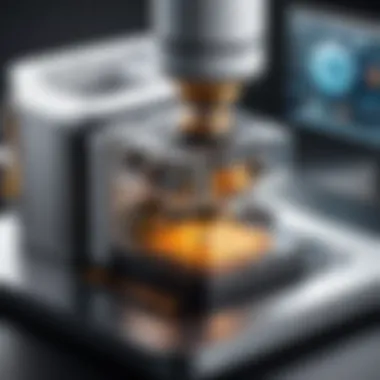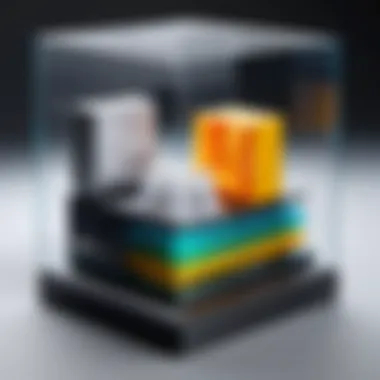Exploring Home SLS Printers: Technology and Applications


Intro
Selective Laser Sintering (SLS) technology has transcended its origins in industrial applications and has begun to find a place within home environments. As 3D printing continues to evolve, home users who are both tech enthusiasts and professionals are increasingly exploring the capabilities and advantages of home SLS printers. Unlike other additive manufacturing methods, SLS offers unique benefits, particularly for creating durable and complex parts rather than mere prototypes.
This guide aims to deepen the reader's understanding of home SLS printers. It will highlight essential features, technology advances, performance assessments, and financial considerations that may impact a purchasing decision. Additionally, it will evaluate the important role home SLS printers can play in hence domestic manufacturing and create an elevated spectrum of contemporary projects.
The content caters to those who seek insightful knowledge, integrating critical elements needed to make informed decisions about adopting SLS technology in personal or professional settings.
Product Overview
The foundation of any home SLS printing established starts with understanding the available models in the market. Readers should familiarize themselves with specific brands specializing in home SLS printers, outline essential specifications, and be aware of the price ranges they might encounter.
Brand Information
Several prominent brands significantly contribute to the landscape of home SLS printers, including Formlabs, Sinterit, and 3D Systems. These brands bring varied options, each with unique selling factors that affect user choice.
Key Specifications
Specifications typically looked for in home SLS printers include:
- Build size: The dimensions that sets the maximum size for printed objects
- Layer thickness: This determines the finess of the print quality
- Supported materials: Compatibility with different types of SLS powders
- Laser power: Influences the efficiency of sintering particles together
Pricing
The prices of home SLS printers vary widely based on capabilities and features. Options can range from approximately two thousand dollars to beyond ten thousand dollars, far exceeding the costs of simpler FDM printing.
Performance Comparison
Examining the performance of home SLS printers reveals crucial insights into their utility. Emerging benchmarks help users assess the quality and swiftness of prints, thereby ensuring optimal usage according to specific needs.
Benchmark Tests
Much emphasis on reliability and efficiency is placed on tests measuring fidelity, precision, and repeatability of prints. Evaluations can be done by comparing samples across various printers outlining intricacies involved.
Speed and Efficiency Comparisons
Users looking for streamlined processes should compare the time that each model increases work efficacy. Full projects must be balanced versus quality to draw in-depth comparisons.
Features and Technology
Understanding the modern features SLS printers possess enhances their appeal.
Unique Features
The integration of intelligent software has made creating self-supporting structures easier. Automated calibrations and safety measures must be planned into designs.
Technological Advancements
Ongoing developments include more compact models without compromising yield rates, enhanced laser efficiency reducing energy consumption significantly.
Compatibility With Other Devices
Compatibility with design software such as CAD programs ensures that users have a smooth journey creating and printing models.
Pros and Cons
Every technology comes with its positives and negatives.
Strengths
- Exceptional repeatability in printing
- Ability to produce complex geometries
- Wide range of sustainable materials available
Areas for Improvement
- Higher compared to other 3D printer prices
- Maintenance can be intricate and cost-relevant
Value for Money
Ultimately, the cost-effectiveness of investing in a home SLS printer needs thorough evaluation. Comparing to other similar technologies helps contextualize choices.
Cost-effectiveness


The upfront purchase price stacks against possible savings from reduced outsourcing for prototyping drives necessity.
Long-term Benefits
Considering capabilities in contexts like manufacturing and developing unique products adds further value through increased autonomy.
Comparison With Similar Products
While FDM printers offer lower entry prices, FDM’s expansion limitations often impede complex design realization in comparison.
In summary, home SLS printers present dynamic solutions for dedicated makers and professionals. Balancing efficiency with an initial investment will ultimately guide prospective users in their purchasing decisions. The now achievable capabilities create tangible utility across multiple sectors.
Prelims to Home SLS Printers
Home SLS printers represent a revolutionary way to approach manufacturing and prototyping at home. The ability to create complex geometries and durable parts directly from a user’s workspace can provide significant advantages. Understanding these printers is imperative for tech enthusiasts and professionals, as they unlock possibilities that were once limited to industrial applications.
Definition and Overview
Selective Laser Sintering (SLS) is a process that utilizes a laser to fuse powdered materials into solid objects. Home SLS printers bring this advanced technology to a more accessible level, allowing for diverse application realms. The printers operate by selectively melting particles of material, layer by layer, building a three-dimensional object. The materials mostly comprise various powders such as nylon or polystyrene, providing significant flexibility in usage. The rise of home SLS has opened doors for individuals to engage in small-scale manufacturing projects and prototyping efficiently, avoiding the need for outsourced production services.
Comparison with Other Printer Types
Home SLS printers differ remarkably from other types of 3D printers. For instance, fused deposition modeling (FDM) printers extrude melted plastic through a nozzle. In contrast, SLS printers work with powder, without requiring filament, often leading to stronger and more intricate structures.
另外,SLS技术省略了支撑结构的需要 these structures can compromise accuracy in lower printing methods. It allows for overhangs and complex shapes without the limitations others might encounter, showcasing the advantage of SLS as a powerful and versatile printing technology.
“Selective Laser Sintering combines precision with versatility, distinctly surpassing other 3D printing methods.”
Each printer type holds unique merits, but home SLS printers present a advanced space amongst home tools for production and creativity.
Understanding Selective Laser Sintering Technology
Selective Laser Sintering (SLS) is pivotal in three-dimensional printing due to its unique process. Exploring SLS technology reveals its potential in advanced prototyping and its role in the future of home manufacturing. Both hobbyists and seasoned professionals find value in it, and understanding its fundamental principles is essential.
Basic Principles of SLS
SLS involves a fine powder material that is sintered together using a high-powered laser. The laser selectively fuses the powder particles together based on the digital 3D model being printed. The result is a solid object built layer by layer. Unlike other 3D printing methods, SLS does not require support structures, significantly enhancing design freedom. Critical points about SLS include:
- Use of thermoplastics, metals, or ceramics.
- Layer-by-layer construction.
- High-level precision and complexity achievable.
Understanding these principles underscores why SLS technology is in demand. It caters to customized production needs where traditional methods may fall short.
Materials Used in SLS Printing
Materials play a vital role in SLS performance. Various powders can be used, notably:
- Nylon: Known for its durability and flexibility, making it optimal for functional parts.
- Polystyrene: Often used for creating intricate prototypes.
- Metal alloys: For parts needing high strength and heat tolerance.
- Ceramics: Useful for applications requiring heat resistance.
The choice of materials affects the performance of the final product and can enhance certain properties like strength or aesthetic finish.
Mechanics of the SLS Process
The SLS process showcases a sequence of steps that characterize its operation:
- Preparation of the bed: A thin layer of powder material is spread across the build platform.
- Laser sintering: The laser traces the first layer, heating the material just enough to fuse particles.
- Layer switching: After completing one layer, the platform lowers, and another layer of powder is applied.
- Cooling process: Post-sintering, the parts cool gradually before removal from the chamber.
The mechanics behind SLS printing enhance its suitability for creating parts with high detail resolución. Keeping in mind these mechanics is crucial for users aiming for efficiency beyond just creating a physical item.
“Understanding SLS technology opens the doors to intricate design possibilities and efficient prototyping.”
Applications of Home SLS Printers
The applications of home Selective Laser Sintering (SLS) printers are diverse and impactful. Exploring these applications shows the depth of their capabilities. Understanding how SLS printers serve industries and individuals can provide insights on their advantages and overall functionality. This section will detail three prominent applications: prototyping and product development, custom manufacturing solutions, and art and design activities. Each of these applications highlights distinct benefits, making SLS printers valuable tools.
Prototyping and Product Development
In the realm of prototyping, home SLS printers play a significant role. Developing initial concepts into physical forms is critical for engineers and designers.
- Rapid Iteration: SLS technology enables quick adjustments. Designers can change a component's design based on feedback, producing new prototypes without delay.
- Functional Testing: Projects often require functional testing of prototypes. SLS printers can produce items that mirror end-use materials and characteristics. This trait enhances the validation process.
- Investment in Innovation: Prototyping leads to innovative products. SLS printers facilitate experimentation by lowering initial costs for prototypes. Being able to create multiple designs rapidly assists designers in developing competitive, trendy products.
Custom Manufacturing Solutions


Home SLS printers enable a significant shift in manufacturing processes. Users can create unique items tailored exactly to specifications. Custom manufacturing offers distinct advantages:
- Personalization: Products can reflect individual preferences. Items made can vary widely, from specialized mechanical parts to houseware tailored for specific needs.
- Limited Production Runs: The ability to easily produce small quantities is appealing to businesses testing markets or niche products.
- Complexity: SLS printing can achieve designs impossible with traditional methods. Intricate structures can be built layer by layer, allowing for innovation in practical designs.
Art and Design Applications
Art and design applications demonstrate the versatility of home SLS printers in creating unique pieces. Artists can leverage this technology to bring concepts to life. The benefits include:
- Creativity Unleashed: Artists can experiment without physical constraints found in traditional materials. They can push artistic boundaries with innovative forms and designs.
- Collaboration: Artists work with designers to create multi-disciplinary pieces. The cooperative nature allows scientists and artists to blend fields, opening new channels for expression.
- Market Expansion: As 3D printing becomes more accepted, artists can reach wider audiences through limited edition products and innovative designs.
Home SLS printers are not just tools; they represent potential. From personalized designs to practical prototypes, the applications are groundbreaking.
Each of these three segments of SLS printer applications contributes significantly to various fields such as engineering, manufacturing, and the arts. The crucial roles help illuminate their varied uses, emphasizing the need to understand the implications of SLS technology in everyday practice.
Advantages of Home SLS Printers
Understanding the advantages of home SLS printers is crucial, especially as their popularity continues to rise among both enthusiasts and professionals. The unique capabilities offered by SLS printing technology can cater to a variety of applications and needs, making them a valuable asset for any workspace.
Precision and Detail
One of the significant advantages of home SLS printers is their remarkable precision and detail in output. Selective Laser Sintering works by melting powdered material layer by layer, which allows for intricate designs with high dimensional accuracy. This characteristic is advantageous in fields requiring fine details, such as architectural modeling or jewelry design. With a layer thickness that can be reduced to just a few hundred microns, SLS printers produce complex geometries that other types of printers struggle to achieve. The iconic example is the production of thin-walled structures and highly detailed prototypes that retain structural integrity without warping or bending under pressure.
"SLS technology consistently delivers exceptional resolution, expanding the potential of personal fabrication in precise fields."
The impressive resolution not only boosts aesthetics but also eliminates the need for excessive post-processing, which is often required for other printing methods. This allows creators to launch their designs more efficiently and helps mitigate human error during finishing processes.
Material Versatility
Home SLS printers boast a wide range of material versatility. Unlike FDM or SLA printers, which often limit materials, SLS printing uses powdered thermoplastics, metals, and composites. Some common materials include nylon, which provides strong and flexible prints, as well as more complex options like PA11 and PA12. This versatility supports customization, allowing users to select materials based on specific requirements.
Moreover, the ability to print with multiple materials simultaneously enhances the capability of dual-composition prints. Such compositions can offer functional benefits, such as varying rigidity or texture within a print. Therefore, users can not only design visually appealing items but also ensure optimal performance and usability for each specific purpose.
Scalability in Production
Another compelling advantage lies in the scalability of production. Home SLS printers enable users to produce smaller batches with ease, transitioning to larger-scale productions at will. The process allows designers to successfully iterate their models quickly, refining details along the way.
As demand increases, adapting existing models into more complex configurations can also be done effectively. For example, custom demands can include design customization driven by user feedback without typically increasing lead time or complicating machinery schedules. Notably, SLS technology permits substantial reductions in time for prototyping and testing, which is essential in dynamic industries.
This adaptability, paired with automation capabilities cropping up in newer models, presents opportunities for businesses and hobbyists to scale 3D printing efforts seamlessly, enhancing their workflow efficiency in cost-effective manners.
Considerations When Choosing a Home SLS Printer
Selecting a home SLS printer demands thorough consideration. This device is more than a simple maker; it represents a substantial investment that can significantly influence your creative and productive capabilities. Understanding the nuances of choosing the right printer helps avoid common pitfalls. It aids in aligning the machine with specific user goals, ensuring that the selected printer meets expectations related to output, cost, and usability.
Budget and Cost Factors
The first consideration that comes to mind is the budget. Home SLS printers vary widely in price. The initial cost not only includes the printer itself but also the ongoing expenses of materials and maintenance. High-quality SLS printers can require a significant financial commitment. Additionally, specific materials suited for SLS printing can bring extra costs, which often increase overall expenditure.
Potential buyers should first establish a realistic budget. Ballpark figures are usually around $2,000 to upwards of $10,000 depending on capabilities and features. For many users, accessories may also play a crucial role in early setups, requiring further investments.
Make a clear checklist of expected costs before making a decision, including:
- Printer cost
- Material costs
- Maintenance fees
- Software licenses
Taking the time to evaluate these elements reduces future financial regrets and could help optimise the investment made into an SLS printer.
Space and Setup Requirements
Next on the list to consider is the space availability. Home SLS printers are generally larger compared to other 3D printer types like FDM or resin printers. This mainly results from the need for a processing chamber, optional cooling systems, and collection features.
Buyers should measure their workspace. Sometimes, it may be necessary to reconfigure a room to facilitate professional or hobbyist printing activities. Apart from the physical area occupied by the printer, suitable ventilation must also be taken into account. Printers may emit fumes, particularly when heating materials or while functioning at high temperatures. Good air circulation is essential for a safety and effective working environment.
The following space considerations should be taken into account:
- Physical dimensions of the printer
- Ventilation needs
- Access to power outlets
Having ample space can provide a better setup experience and enhance workflow efficiency.
Ease of Use and Software Compatibility
Finally, ease of use and software compatibility stand as crucial factors in the choice of a home SLS printer. Many printers come equipped with specialized software for print orchestration and management. Some offerings, while technologically advanced, can be less user-friendly..


Consider machinery that features intuitive interfaces and guides. Particularly for newcomers, complexity can serve as a frustrating barrier when getting started. Review available software compatibility, ensuring that the selected printer integrates well with popular 3D modeling and design software like Blender or SolidWorks.
Here are aspect of ease of use that should not be overlooked:
- User Interface features
- Quality and training of customer support
- Editing and slicing of models
Select an SLS printer that simplifies the printing process, enabling productive workflow without steep learning curves.
Maintenance and Care for Home SLS Printers
Regular maintenance and care are crucial for ensuring the optimal performance and longevity of home SLS printers. These machines, while revolutionary in their capabilities, require thoughtful handling and regular upkeep to function correctly. Neglecting maintenance can lead to more serious issues that could compromise results or potentially damage the device.
Proper care leads to enhanced print quality, reduces the occurrence of errors, and can keep repair cost at bay. Understanding how to properly maintain these printers ensures reliable performance during significant projects.
Routine Maintenance Practices
Routine maintenance practices are essential for sustaining performance levels in a home SLS printer. Some general tasks include:
- Cleaning Build Chamber: Regularly cleaned build chambers prevent material buildup that can impair functionality. Scraps and leftover powder, if left unattended, can affect new prints.
- Check and Replace Fatigue Parts: Over time, certain components wear out due to usage. Keeping an eye on items such as thermostats and reflectors helps avoid sudden equipment failures during essential printing tasks.
- Calibration: Calibration ensures accuracy in print dimensions, aligning the laser path correctly. Regular checks maintain the precision that SLS technology is known for and can reduce errors in printed items.
Focusing on these tasks is vital for both product quality and extending the life of the printer. Documenting maintenance schedules and following them methodically can be efficient in this regard. Quick replacement or adjustment of parts will minimize downtime.
Troubleshooting Common Issues
Even with diligent maintenance, issues may still arise. It is essential to identify common problems and their corresponding solutions.
- Poor Print Quality: Check for issues with the material or misalignments in the printer. Blockages in the laser path or an uncalibrated head may degrade quality. Cleaning optics and recalibrating laser positioning often resolves this.
- Layer Separation: This might indicate inadequate heating or inappropriate settings for the selected material. This is critical to examine, adjusting temperature settings when needed to ensure proper fusion.
- Extrusions Problems: Notice any skip or inconsistency in powder placement, resulting in uneven prints. Cleaning the feed system helps maintain smooth operations.
Tackling common issues quickly can prevent minor problems from escalating.
Investing time into routine maintenance as well as understanding troubleshooting methods significantly contributes to a better printing experience. This approach not only diminishes hassle but also empowers users, helping them maximize their SLS printer's capabilities.
Future Trends in SLS Technology
Future trends in SLS technology represent a significant leap forward for home manufacturing and digital fabrication. As technology advances, understanding these trends will help users harness the full potential of their home SLS printers. This section delves into key areas that promise to reshape the landscape of SLS printing: innovative material development, automation, and the implications for home-based manufacturing practices.
Innovative Material Development
Material innovation is crucial for enhancing the performance and applicability of SLS printing. Recent advancements have broadened the range of materials, offering improved mechanical properties, chemical resistance, and flexibility.
- Plastic Materials: Discoveries in thermoplastics, such as nylon blends and Polly woo-die cloth, are increasingly relevant. These materials not only improve durability but also create lightweight structures ideal for various applications.
- Metallic Materials: Companies like EOS and 3D Systems have been working on more accessible metal powders for home printers. This redefines the potential for metal printing in hobby and professional contexts.
- Biodegradable Options: With sustainable practices in mind, innovators are experimenting with materials derived from renewable resources, which aligns with global trends toward eco-conscious manufacturing.
These developments could lead to enriched printing capabilities, attracting both DIY enthusiasts and professionals seeking high-performance production solutions.
Advances in Automation
The push for automation in SLS technology brings into play devices that minimize manual intervention, thus streamlining the printing process. Automation integrates sophisticated systems that control processes with minimal human input, enhancing productivity.
- Smart Monitoring Systems: Many manufacturers are incorporating real-time monitoring systems into their printers. These systems can alert users to potential issues during printing, ensuring high-quality results without constant supervision.
- Material Handling Automation: Innovations are reducing the need for manual loading and unloading of materials. This leads to faster job turnovers and greater efficiency in the workflow.
- Software Integration: Improved software solutions facilitate a more intuitive design-to-print transition. They reduce the learning curve and allow easier adjustments during the printing process.
These advancements point to a future where home SLS printing becomes more accessible and user-friendly, potentially attracting a wider audience to leverage these powerful tools.
Implications for Home Manufacturing
The upward trend in SLS technology has significant implications for future home manufacturing landscapes. As the technology becomes more refined and integrated, more individuals can explore 3D printing with SLS at a personal and community level.
- Personalized Production: Users can engage in customized production workflows tailored to their unique needs, making personal manufacturing more feasible.
- Cost Reduction: As technological advancements lead to streamlined processes and better materials, costs might decrease. This positions home SLS printers as viable tools for small businesses and hobbyists alike.
- Community Fab Labs: As SLS printing becomes more popular, local fab labs could emerge, combining personal production capabilities with community resources, fostering collaboration.
This paradigm shift invites a reconsideration of what it means to manufacture at home, marking a turn toward innovation and increased productivity.
The End
As we conclude our exploration of home SLS printers, it is essential to underscore their significant impact on modern manufacturing and design. The rise of Selective Laser Sintering technology in residential settings marks a pivotal moment for creators and innovators alike. By assimilating this technology into home environments, users amplify their capabilities for both professional projects and personal pursuits.
Understanding the core competencies and unique advantages offered by home SLS printers facilitates informed decisions for potential buyers. It is not merely about owning a machine; it encompasses acknowledging the precision, material versatility, and the broader scalability it provides in producing intricate designs or prototypes. Each printer offers distinct strengths and limitations, which require careful evaluation depending on individual needs and goals.
Moreover, deliberating over budget, required space, and software compatibility is paramount when surveying the home SLS printer market. These considerations govern not just the initial expenditure but also the long-term success and satisfaction with the technology integrated into your workflow. One must weigh the pros and cons to ensure a prudent investment.
Looking ahead, the future of SLS technology seems promising, with innovative materials and advances in automation on the horizon. This evolution signifies that home SLS printers will increasingly foster ingenuity and streamline processes, making unique creations attainable at a personal level.
In summary, integrating home SLS printers offers enriching benefits and potential pitfalls. It encourages exploration, experimentation, and a new level of customization that reflects personal and professional aspirations. Therefore, staying informed and engaged with developments in this space becomes critical for users aiming to maximize their printing capabilities.
Final Thoughts on Home SLS Printers
Home SLS printers represent a versatil diverse_solution_for individuals engaged in a variety of fields, from designers to engineers. The flexibility in materials provided fosters limitless creativity, showcasing how technology can empower personal manufacturing.
It is also worth considering the environmental impact associated with traditional manufacturing methods. Home SLS printers can reduce waste significantly in prototype development. Thus, choosing an SLS printer aligns closely with more sustainable practices that cater to environmentally-conscious creators.
In closing, as home SLS printers continue to develop and mature within the market, they will likely reshape the very nature of how we conceive, design, and produce not just individual items, but entire ecosystems of elective solutions designed to meet various challenges of modern life.







